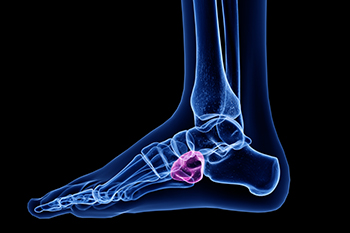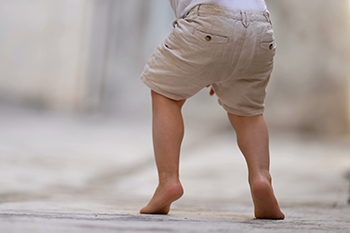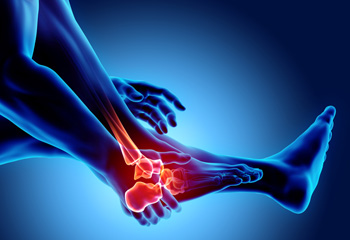Items filtered by date: February 2024
The Importance of Wearing Properly Fitting Shoes

In our modern world dominated by concrete and cement, the demise of shoes seems unlikely. This reliance, however, has led to chronic back and foot pain. Podiatrists play an important role in addressing these issues. Wearing improper or ill-fitting shoes can lead to various problems, from bunions to muscle tension and even plantar fasciitis. Choosing the right shoes involves considering factors like foot swelling throughout the day and ensuring proper fit and support. Additionally, rotating shoes to engage different muscles and replacing worn out ones are important practices. A podiatrist can offer personalized advice and treatments to alleviate foot pain and prevent future issues, emphasizing the importance of footwear in maintaining healthy and pain-free feet. If you would like guidance in making sure you get the right sized shoes that fit your feet well, it is suggested that you schedule an appointment with a podiatrist for a consultation.
Getting the right shoe size is an important part of proper foot health. Seek the assistance of Donald Manger, DPM from Associated Podiatric Physicians, PA. Our doctor will provide the care you need to keep you pain-free and on your feet.
Getting the Right Shoe Size
There are many people who wear shoes that are the incorrect size, negatively affecting their feet and posture. Selecting the right shoes is not a difficult process, so long as you keep several things in mind when it comes to choosing the right pair.
- When visiting the shoe store, use the tools available to measure your foot.
- Be sure there is ‘wiggle room’. There should be about an inch between your toes and the tip of your shoes.
- Do not always assume you are the same size, as manufacturers run differently.
- Purchase shoes later in the day, as your feet swell as the day progresses.
- If a shoe is not comfortable, it is not suitable. Most shoes can’t be ‘broken in’, and comfort should be the ultimate goal when it comes to choosing the right pair of shoes
As our feet hold our body weight and keep us moving, it is important to treat them right. Picking the right pair of shoes can provide your feet comfort and mobility without pain.
If you have any questions, please feel free to contact our office located in Hamilton Township, NJ . We offer the newest diagnostic and treatment technologies for all your foot care needs.
Foot Pain Caused by Cuboid Syndrome
 Cuboid syndrome is a foot condition in which the cuboid bone has been displaced due to stress on the foot. Someone with cuboid syndrome may experience pain on the outer side of the foot, particularly in the midfoot area, which can worsen with weight-bearing activities like walking or running. The patient’s foot may be swollen, tender to the touch, and difficult to stand on. Additionally, they might complain of discomfort or pain during sports and physical activity. Early recognition and intervention can help alleviate symptoms and prevent long-term complications, allowing patients to return to their normal activities. If you have any of these symptoms, it is suggested you seek medical attention from a podiatrist who can diagnose and treat the source of the pain.
Cuboid syndrome is a foot condition in which the cuboid bone has been displaced due to stress on the foot. Someone with cuboid syndrome may experience pain on the outer side of the foot, particularly in the midfoot area, which can worsen with weight-bearing activities like walking or running. The patient’s foot may be swollen, tender to the touch, and difficult to stand on. Additionally, they might complain of discomfort or pain during sports and physical activity. Early recognition and intervention can help alleviate symptoms and prevent long-term complications, allowing patients to return to their normal activities. If you have any of these symptoms, it is suggested you seek medical attention from a podiatrist who can diagnose and treat the source of the pain.
Cuboid syndrome, also known as cuboid subluxation, occurs when the joints and ligaments near the cuboid bone in the foot become torn. If you have cuboid syndrome, consult with Donald Manger, DPM from Associated Podiatric Physicians, PA. Our doctor will assess your condition and provide you with quality foot and ankle treatment.
Cuboid syndrome is a common cause of lateral foot pain, which is pain on the outside of the foot. The condition may happen suddenly due to an ankle sprain, or it may develop slowly overtime from repetitive tension through the bone and surrounding structures.
Causes
The most common causes of cuboid syndrome include:
- Injury – The most common cause of this ailment is an ankle sprain.
- Repetitive Strain – Tension placed through the peroneus longus muscle from repetitive activities such as jumping and running may cause excessive traction on the bone causing it to sublux.
- Altered Foot Biomechanics – Most people suffering from cuboid subluxation have flat feet.
Symptoms
A common symptom of cuboid syndrome is pain along the outside of the foot which can be felt in the ankle and toes. This pain may create walking difficulties and may cause those with the condition to walk with a limp.
Diagnosis
Diagnosis of cuboid syndrome is often difficult, and it is often misdiagnosed. X-rays, MRIs and CT scans often fail to properly show the cuboid subluxation. Although there isn’t a specific test used to diagnose cuboid syndrome, your podiatrist will usually check if pain is felt while pressing firmly on the cuboid bone of your foot.
Treatment
Just as the range of causes varies widely, so do treatments. Some more common treatments are ice therapy, rest, exercise, taping, and orthotics.
If you have any questions, please feel free to contact our office located in Hamilton Township, NJ . We offer the newest diagnostic and treatment technologies for all your foot care needs.
Understanding Toe Walking in Toddlers

Understanding toe walking in toddlers is important for parents to discern normal development from potential issues. It's common for children under two years old to exhibit toe walking as they learn to walk. Toe walking is defined as the absence of heel strike during initial contact. It typically resolves as the child grows older, with most children demonstrating ankle dorsiflexion by age of five. However, toe walking can also be associated with specific conditions like cerebral palsy, muscular dystrophy, or autism spectrum disorders. For that reason, it's important to distinguish idiopathic toe walking, or ITW, where no pathology exists, from toe walking caused by underlying conditions. Recent studies suggest that more than half of young toe walkers will not face significant developmental or neuropsychiatric issues. While parents should monitor their child's development closely, toe walking alone isn't always indicative of a serious problem. If your child continues to toe walk past the age of five, it is suggested that you consult a podiatrist who can conduct a thorough exam and suggest the next course of action.
If you have any concerns about your feet, contact Donald Manger, DPM from Associated Podiatric Physicians, PA. Our doctor can provide the care you need to keep you pain-free and on your feet.
Biomechanics in Podiatry
Podiatric biomechanics is a particular sector of specialty podiatry with licensed practitioners who are trained to diagnose and treat conditions affecting the foot, ankle and lower leg. Biomechanics deals with the forces that act against the body, causing an interference with the biological structures. It focuses on the movement of the ankle, the foot and the forces that interact with them.
A History of Biomechanics
- Biomechanics dates back to the BC era in Egypt where evidence of professional foot care has been recorded.
- In 1974, biomechanics gained a higher profile from the studies of Merton Root, who claimed that by changing or controlling the forces between the ankle and the foot, corrections or conditions could be implemented to gain strength and coordination in the area.
Modern technological improvements are based on past theories and therapeutic processes that provide a better understanding of podiatric concepts for biomechanics. Computers can provide accurate information about the forces and patterns of the feet and lower legs.
Understanding biomechanics of the feet can help improve and eliminate pain, stopping further stress to the foot.
If you have any questions please feel free to contact our office located in Hamilton Township, NJ . We offer the newest diagnostic and treatment technologies for all your foot and ankle needs.
It's Time for Beautiful Feet
The Anatomy of a Foot Stress Fracture

A foot stress fracture is a common injury resulting from repetitive strain and overuse of the bones in the foot. Unlike acute fractures caused by sudden trauma, stress fractures develop gradually due to the cumulative effect of repetitive stress on the bones, often stemming from activities like running, jumping, or prolonged standing. These microcracks typically occur in weight-bearing bones, such as the metatarsals, and can lead to localized pain, swelling, and tenderness. Foot stress fractures are particularly prevalent among athletes and individuals engaged in high-impact activities. Recognizing the symptoms, which may mimic other foot conditions, is essential for an accurate diagnosis and timely intervention. Rest, along with wearing proper footwear and a gradual return to activity, forms the cornerstone of treatment. If you have endured a foot stress fracture, it is suggested that you consult a podiatrist who can confirm the diagnosis and offer the treatment method that is best for you.
Stress fractures occur when there is a tiny crack within a bone. To learn more, contact Donald Manger, DPM from Associated Podiatric Physicians, PA. Our doctor can provide the care you need to keep you pain free and on your feet.
How Are They Caused?
Stress fractures are the result of repetitive force being placed on the bone. Since the lower leg and feet often carry most of the body’s weight, stress fractures are likely to occur in these areas. If you rush into a new exercise, you are more likely to develop a stress fracture since you are starting too much, too soon. Pain resulting from stress fractures may go unnoticed at first, however it may start to worsen over time.
Risk Factors
- Gender – They are more commonly found in women compared to men.
- Foot Problems – People with unusual arches in their feet are more likely to develop stress fractures.
- Certain Sports – Dancers, gymnasts, tennis players, runners, and basketball players are more likely to develop stress fractures.
- Lack of Nutrients – A lack of vitamin D and calcium may weaken the bones and make you more prone to stress fractures
- Weak Bones – Osteoporosis can weaken the bones therefore resulting in stress fractures
Stress fractures do not always heal properly, so it is important that you seek help from a podiatrist if you suspect you may have one. Ignoring your stress fracture may cause it to worsen, and you may develop chronic pain as well as additional fractures.
If you have any questions, please feel free to contact our office located in Hamilton Township, NJ . We offer the newest diagnostic and treatment technologies for all your foot care needs.

